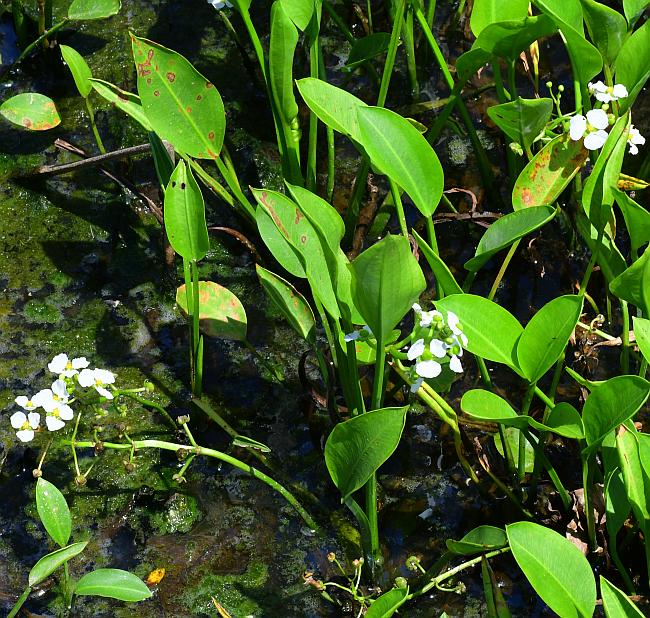Sagittaria graminea Michx.
Grassy Arrowhead

Native
CC = 6
CW = -5
MOC = 36
© SRTurner
Sagittaria graminea Michx.Grassy Arrowhead | |
 |
Native CC = 6 CW = -5 MOC = 36 |
© SRTurner |
|
Family - Alismataceae Habit - Perennial emergent aquatic forb, monoecious, with rhizomes and corms. Stems - Aerial stems absent. Leaves - Basal, simple, long-petiolate, 10-55 cm long, the petioles rounded to flattened, the blades of submerged leaves absent or linear, the blades of emergent leaves linear to ovate, sometimes with a pair of basal lobes.
Inflorescences - Unbranched racemes with whorled flowers, ascending to erect. Bracts at nodes of the inflorescence 3-7 mm long, fused in the basal half, the free portions triangular, acute. Lower 1-5 whorls of flowers pistillate, with ascending to spreading, unthickened pedicels 8-24 mm long. Sepals reflexed in fruit.
Flowers - Actinomorphic, unisexual. Sepals 3, green. Petals 3, white, dropping soon after flowers open. Stamens and pistils numerous. Pistils separate, in a dense, headlike cluster on an expanded receptacle. Style 1 per pistil, the stigma decurrent. Ovaries superior, with 1 ovule. Filaments of stamens shorter than to about as long as the anthers, swollen basally, minutely roughened or papillose.
Fruits - Fruiting pedicels stout, usually reflexed. Achenes obovate, 1.4-2.0 mm long, beakless or the beak to 0.3 mm long, triangular, spreading at a right angle to the body of the fruit.
Flowering - May - September. Habitat - Pond margins, ditches, sloughs. Origin - Native to the U.S. Lookalikes - Other species of Sagittaria, especially S. platyphylla. Other info. - Like other species of Sagittaria, this is found in wet, muddy places, often in standing water. It occurs in scattered locations throughout much of the state, and in likewise scattered fashion throughout much of the eastern U.S. It is most common in areas along the Atlantic and Gulf Coasts. The plant is identified to genus by its wet habitat, thick leaves on fleshy petioles, and distinctive flowers which come in discrete staminate and pistillate forms. Identification to species is more challenging, and differentiation from S. platyphylla in particular is very difficult. Subtle details of the inflorescence bracts, pedicels, and achene beaks have been used to distinguish the species, but there is some doubt that they are truly distinct, and more study is needed. Photographs taken near Otter Slough Conservation Area, Stoddard County, MO, 7-31-2015 and 8-7-2022 (SRTurner). |